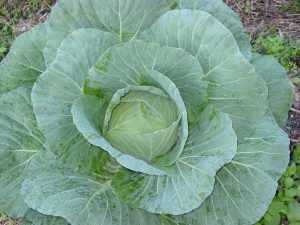
Why would I encourage you to grow cabbage in your backyard garden when it is one of the most affordable green vegetables you could pick up at the grocery store? Well, cabbage is perhaps the easiest fall vegetable to grow in our area. Cabbage also offers a beautiful display with a wide variety of sizes, colors, and textures. And, in a pinch, you have access to fresh, ready-to-pick cabbage right in your own backyard.
Starting from scratch, now is the time to start cabbage from seeds. Cabbage will take about four-weeks from seed to grow into small transplants suitable for your garden. While there are a few packets left on the local seed racks, you can also check out online seed catalog sources. There are numerous types of heading cabbage to choose from including ‘Flat Dutch’, ‘Round Dutch’, and ‘Copenhagen Market’. ‘Early Jersey Wakefield’ cabbage produce pointed heads, while Savoy-type cabbage have crinkly, crunchy leaves for added texture. Red cabbage such as ‘Red Acre’ offers a reddish-purple color adding to your cabbage universe – try them all. Cabbage size varies from large cultivars weighing many pounds to small, space-saving types suitable for small gardens weighing two-pounds or less.
Very soon, if not already, cabbage seedlings will begin to make an appearance at local garden centers. While variety may be limited, these seedlings can offer a convenient option in six to nine pack offerings. After locating a full-sun site in your yard, prepare the soil by working in compost/composted manure and slow-release granular vegetable fertilizer as per label directions. Space cabbage seedlings twenty-four inches between rows and about sixteen inches between plants for best results. Side dress with more granular fertilizer as per label directions to continue strong, steady growth – liquid fertilizer many also be used as a substitute. Plan on picking your cabbage anywhere from seventy days and up from the time seedlings are planted until harvest depending on the cultivar. While you may end up with more cabbage than you can consume, consider sharing some with a neighbor or friend – they will be impressed with your efforts!
Cabbage pests can pop up from time to time. Seedlings should each have a four-inch tall “cutworm collar” to protect them from the stem-gnawing damage caused by these plump nocturnal caterpillars. Aphids may also infest cabbage leaves – monitor often and use a least-toxic insecticide such as insecticidal soap as per label directions to suppress these pests. Certain caterpillars may also feed on the cabbage foliage – use Spinosad as per label directions to control them. Chicken wire fencing will likely be required to keep out rabbits. These critters do not want to share and a mechanical barrier such as a thirty-inch-tall fence will keep them out.
You will impress yourself with how beautiful your first cabbage crop looks. By then you will be hooked and want to grow more and expand your vegetable palette to new edible horizons! For more information on all types of cool season vegetable crops to grow, or to ask a question, you can also call the Master Gardener Volunteer Helpdesk on Mondays, Wednesdays, and Fridays from 1 to 4 pm at 764-4340 for gardening help and insight into their role as an Extension volunteer.
Ralph E. Mitchell is the Director/Horticulture Agent for UF/IFAS Extension – Charlotte County. He can be reached at 941-764-4344 or ralph.mitchell@charlottecountyfl.gov. Connect with us on social media. Like us on Facebook @CharlotteCountyExtension and follow us on Instagram @ifascharco.
Resources:
UF/IFAS Extension Gardening Solutions (2024) Cabbage. The University of Florida Extension Service, IFAS.
Lamborn, A. (2018) Tips for Growing Cabbage. The University of Florida Extension Service, IFAS – Baker County.
Wikipedia – Savoy Cabbage. https://en.wikipedia.org/wiki/Savoy_cabbage .
Brown, S. P., Treadwell, D., Stephens, J. M., & Webb, S. (2021) Florida Vegetable Gardening Guide. The University of Florida Extension Service, IFAS.
 0
0
